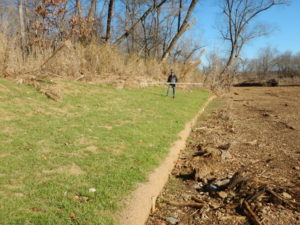White River at Noland Waste Water Treatment Plant
Before
After
The Watershed Conservation Resource Center (WCRC) worked with project partners to stabilize a riverbank on the White River near the Nolan Wastewater Treatment Plant in Fayetteville, AR. Beaver Reservoir is located only a few miles downstream of the project site. The project was funded by an EPA Section 319(h) grant administered by the Arkansas Natural Resources Commission with matching funds provided by the City of Fayetteville and other project partners. Implementation of the bank stabilization plan began in October 2015 and was completed in December 2016.
Background
The White River, located in Northwest Arkansas, forms Beaver Lake, which is the primary drinking water source for over 400,000 people in NW Arkansas. The Arkansas Department of Environmental Quality placed the White River on the 1998 State 303(d) list of impaired waterways citing sedimentation and turbidity issues as a result of surface erosion, which includes streambank erosion, as the cause. As of 2017, the White River remains on the impaired list. Measurement of erosion indicated that the bank was retreating at an average rate of over 8 ft/yr generating over 4,800 tons of sediment each year. Erosion of the riverbank also contributed over 11,000 lb of total nitrogen and over 4,000 lb of total phosphorus to the waterway yearly.
Design & Implementation
The WCRC utilized natural channel design principles to develop the restoration plan. Streamline Environmental, LLC of Magnolia Springs, AL constructed the channel to specific dimensions designed to restore the river to a stable form based on local reference reach data. A ͚toe wood͛ bench was designed and constructed using large trees, boulders, and gravel. Trees for the project were salvaged from local construction developments. The edge of the bench, with exposed root wads and boulders provides excellent fish habitat and also reduces the power of the passing floodwaters. The use of native vegetation is a critical component of the stabilization design. Soil layers consisting of topsoil wrapped in a coconut fiber blanket, were constructed on top of the two benches, provide a medium for plants to take root and grow and provide additional weight to secure the trees used in the structure. These soil lifts were seeded with a mix of native riparian seed types. Approximately 500 trees, 4,000 shrubs, and 1,000 grass plugs. Maturing plants help to bind the structure through root growth and will also help to dissipate water velocity as the leaves, branches, and stems of the plants interact with flood waters.
Post Restoration
The restored bank provides water quality benefits almost immediately following construction. Several floods have taken place since the completion of heavy construction and inspections conducted indicated that little to no measurable erosion occurred along the previously actively eroding riverbank.